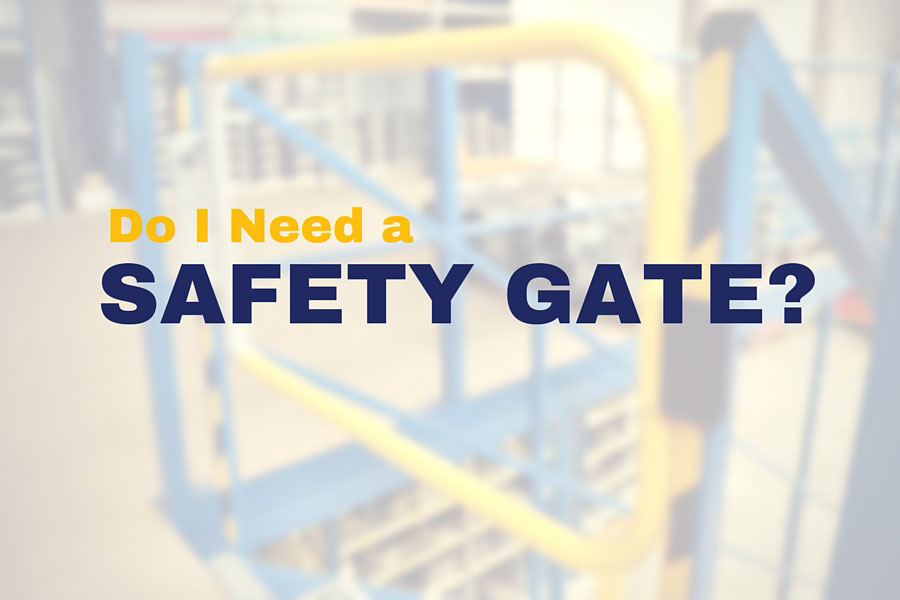Do I Need an Industrial Safety Gate?

Take a look around the neighborhood you live in. How many fences do you see? Probably quite a few, right? And, where you see fences, how many have no gates? I would venture to guess that the answer is “very few if any.” That’s because a fence is put up for a reason: to keep animals and/or people either in your yard or out of your yard. Without a gate, the fence cannot truly serve its purpose. And yet, on job sites across America, railing after railing is erected to protect workers from falling – on roofs, on scaffolds, on all types of elevated work areas - without any mechanism to protect those same workers at the edge or floor opening from which they are accessing that work area. Why? How can railings be effective if they don’t offer complete protection? What good does a perimeter railing do if a worker can fall through the hole in which their ladder is situated?
Industrial safety gates have been around for a long time, but for a variety of reasons, they are often not used. Sometimes it’s a lack of planning, other times it is lack of knowledge of product availability, and other times maybe it’s cost (though, if you’re spending the money to build or purchase a rail, the addition of a gate is minimal cost-wise). Whatever the reason, workers are being left unprotected and, worse yet, being given a false sense of security.
So what does OSHA say on the topic of industrial gates? Are they required? Well, not outright. Let’s remember that OSHA rarely if ever specifies how you must abate a hazard. What the regulations will say is that if you choose to solve it via method x or method y, then here are the requirements that method x or method y must meet. For example, OSHA provides regulations stating what criteria fall protection equipment must meet, but at no time does OSHA state that you MUST use rails, or nets, or personal fall arrest systems. The same applies here. OSHA doesn’t say you MUST use a gate, but gives situations in which a gate could be your solution and, if you so choose, what requirements must that safety gate meet.
Confused? Okay, here’s what OSHA says, for example, about guarding a ladderway floor opening or the access area to your platform:
OSHA 1910.29 (b)
The employer must ensure guardrail systems meet the following requirements: (13)(i) Has a self-closing gate that slides or swings away from the hole, and is equipped with a top rail and mid-rail, or equivalent intermediate member, that meets the requirements in paragraph (b) of this section; or (13)(ii) is offset to prevent an employee from walking or falling into the hole.
So, while OSHA is stating that these openings need to be protected by rails, they are stating that a gate is one way to protect the opening, the other being an offset. From a best practices standpoint, a physical barrier is always better than something that requires human diligence because humans make mistakes, humans get tired, and humans get distracted. Keep in mind, that if you decide to use the gate, it must offer equal protection to the rest of the railing. That means, top and mid-rails at the same heights and being able to withstand the same amount of force.
Another organization you should be familiar with, ANSI (the American National Standards Institute) addresses safety gates in relation to pallet drop areas. In ANSI MH 28.3-2009 section 6.4.3, a barrier is required to be in place to secure pallet drop areas at all times, even while the area is being used for handling materials. This means that a simple swing gate, sliding, gate, chain, or removable railing is not acceptable. Only a dual-gate system would work in this situation because a barrier would remain in place at all times. Remember, ANSI are not regulations, they are guidelines. Often, OSHA will consider them best practice or industry-accepted practices, but unless they are incorporated into the OSHA regulations by reference (or into the regulations of the state agency under whose jurisdiction you fall) they are not law. However, when a standard exists which is safer than what you are doing, it’s a good idea to do everything you can to meet that standard because in a court of law, you would need to be able to defend why you didn’t follow the recommendations of an organization as well-known, and widely referenced as ANSI, if their methods might have prevented an accident at your facility or site.
Industrial safety gates are an easy to install, easy to use control that leaves very little room for human error. They do not hinder productivity or work quality and will help keep your employees, inspectors, contractors, and visitors safe. A small investment keeps you compliant and your employees free from harm.


